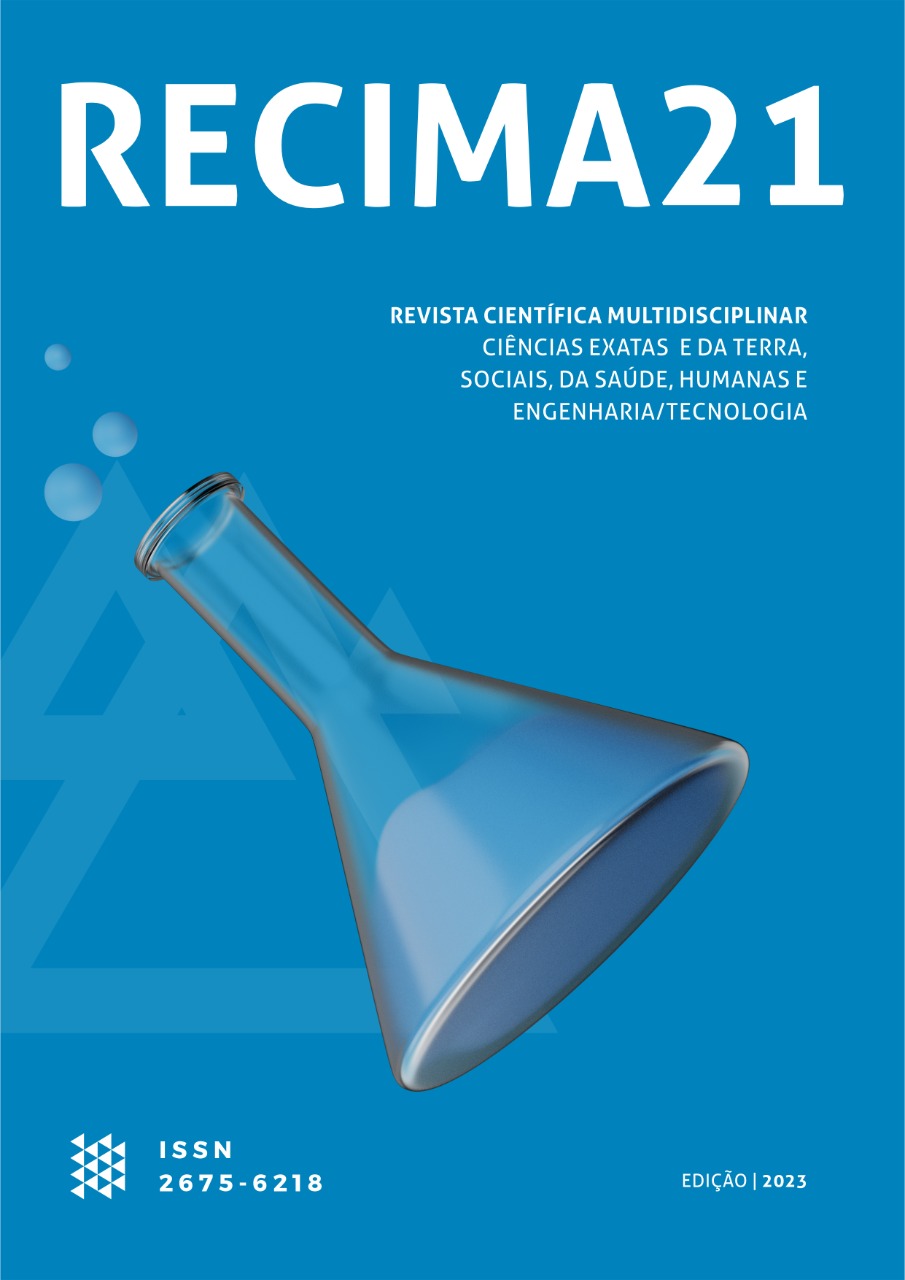INVESTIGACIÓN CON PACIENTES CON ENFERMEDAD DE PARKINSON EN BRASIL – UNA REVISIÓN INTEGRADORA
DOI:
https://doi.org/10.47820/recima21.v4i6.3285Palabras clave:
enfermedad crónica que afectaResumen
La enfermedad de Parkinson (EP) es una enfermedad crónica que afecta a unos 6,1 millones de personas y que ocupa el primer lugar en el ranking de las afecciones neurodegenerativas que más crecen en número de portadores en el mundo (DORSEY et al, 2018). La EP, que es conocida principalmente por sus síntomas motores, hoy tiene un cuadro clínico ampliado, con síntomas neuropsiquiátricos, autonómicos y sensoriales. Hasta la fecha, el tratamiento de la EP se realiza principalmente con levodopa (L-DOPA), que, al principio, es eficaz para los síntomas motores. Sin embargo, la terapia no interrumpe la progresión de la enfermedad y con el tiempo puede perder su eficacia, requiriendo ajustes y complementaciones con otros fármacos y terapias. Por lo tanto, el objetivo de este estudio es compilar las terapias para la enfermedad de Parkinson que actualmente están siendo investigadas por ensayos clínicos en el contexto brasileño. Para ello, se realizó una revisión integradora de la literatura científica basada en artículos disponibles en las siguientes plataformas: Scientific Electronic Library Online – SCIELO, la U.S. National Library of Medicine (NLM) – PubMed y ScienceDirect. Su objetivo, a través de esto, es recopilar información útil para el tratamiento clínico más amplio / holístico de pacientes con enfermedad de Parkinson. Los estudios han demostrado el valor de la estimulación cerebral profunda (DBS), L-DOPA más allá de los síntomas motores, el ejercicio y el manejo de caídas en el tratamiento de la enfermedad.
Descargas
Citas
ALBERTS, J. L.; ROSENFELDT, A. B. The Universal Prescription for Parkinson’s Disease: Exercise. Journal of Parkinson’s Disease, v. 10, n. s1, p. S21–S27, 1 set. 2020. Disponível em: <https://www.ncbi.nlm.nih.gov/pmc/articles/PMC7592674/>.
ALVES DA ROCHA, P.; MCCLELLAND, J.; MORRIS, M. E. Complementary physical therapies for movement disorders in Parkinson’s disease: a systematic review. European Journal of Physical and Rehabilitation Medicine, v. 51, n. 6, p. 693–704, 1 dez. 2015. Disponível em: <https://pubmed.ncbi.nlm.nih.gov/26138090/>.
ARAÚJO-SILVA, F. et al. Temporal dynamics of cortical activity and postural control in response to the first levodopa dose of the day in people with Parkinson’s disease. Brain Research, v. 1775, p. 147727, 15 jan. 2022. Disponível em: https://pubmed.ncbi.nlm.nih.gov/34788638/.
ARTEN, T. L. S.; HAMDAN, A. C. Executive functions and memory in Parkinson’s disease patients with Deep Brain Stimulation. Aging and Health Research, v. 2, n. 1, p.100065, mar. 2022. Disponível em: https://doi.org/10.1590/1980-57642020dn14-020012.
BECKER, D. et al. Onset of Postural Instability in Parkinson’s Disease Depends on Age rather than Disease Duration. Parkinson’s Disease, v. 2022, p. 6233835, 2022. Disponível em: <https://www.ncbi.nlm.nih.gov/pmc/articles/PMC9734006/>.
BERRIOS, G. E. Introdução à “Paralisia agitante”, de James Parkinson (1817). Revista Latinoamericana de Psicopatologia Fundamental, v. 19, p. 114–121, 2016. Disponível em: https://doi.org/10.1590/1415-4714.2016v19n1p114.9.
BOCCOLINI, C. S.; CAMARGO, A. T. S. P. Morbimortalidade por Doenças Crônicas no Brasil: situação atual e futura. Rio de Janeiro: Fundação Oswaldo Cruz, 2016. 25 p. (Série Saúde Amanhã). Disponível em: https://saudeamanha.fiocruz.br/wp-content/uploads/2017/11/PJSSaudeAmanha_Texto0022_2016_v05.pdf.
BRUNTON, L. L.; HILAL-DANDAN, R.; KNOLLMANN, B. C. Goodman & Gilman’s the pharmacological basis of therapeutics. 13. ed. New York: McGraw-Hill Education, 2019.
BUCUR, M.; PAPAGNO, C. Deep Brain Stimulation in Parkinson Disease: A Meta-analysis of the Long-term Neuropsychological Outcomes. Neuropsychology Review, 23 mar. 2022. Disponível em: <https://www.ncbi.nlm.nih.gov/pmc/articles/PMC10148791/>.
CHAO Y, Gang L, Na Z, Ming W, Zhong W, Mian W. Tratamento cirúrgico da doença de Parkinson: atualização e revisão. Interv Neuroradiol. 2007 dezembro; 13 (4):359–368. doi: 10.1177/159101990701300407.
CHENG, P. et al. Comparative Effectiveness of Published Interventions for Elderly Fall Prevention: A Systematic Review and Network Meta-Analysis. International Journal of Environmental Research and Public Health, v. 15, n. 3, p. 498, 12 mar. 2018. Disponível em: <https://www.ncbi.nlm.nih.gov/pmc/articles/PMC5877043/>.
COLCOMBE, S. J. et al. Aerobic fitness reduces brain tissue loss in aging humans. The journals of gerontology. Series A, Biological sciences and medical sciences, v. 58, n. 2, p. 176–80, 2003. Disponível em: <https://pubmed.ncbi.nlm.nih.gov/12586857/>.
CRUISE, K. E. et al. Exercise and Parkinson’s: benefits for cognition and quality of life. Acta Neurologica Scandinavica, v. 123, n. 1, p. 13–19, 3 dez. 2010. Disponível em: <https://pubmed.ncbi.nlm.nih.gov/20199518/>.
DE LUCCA, M. E. T. et al. Quality of life of patients with Parkinson’s disease: a comparison between preoperative and postoperative states among those who were treated with deep brain stimulation. Arquivos de Neuro-Psiquiatria, v. 80, n. 4, p. 391–398, abr. 2022.
DE VRIES, M. et al. Fall-Risk-Increasing Drugs: A Systematic Review and Meta-Analysis: I. Cardiovascular Drugs. Journal of the American Medical Directors Association, v. 19, n. 4, p. 371.e1–371.e9, abr. 2018. Disponível em: <https://www.jamda.com/article/S1525-8610(17)30698-9/fulltext>.
DORSEY, E. R. et al. Global, regional, and national burden of Parkinson’s disease, 1990–2016: a systematic analysis for the Global Burden of Disease Study 2016. The Lancet Neurology, v. 17, n. 11, p. 939–953, nov. 2018. Disponível em: https://www.thelancet.com/journals/laneur/article/PIIS1474- 4422(18)30295-3/fulltext>.
DUARTE, J. DOS S. et al. Physical activity based on dance movements as complementary therapy for Parkinson’s disease: Effects on movement, executive functions, depressive symptoms, and quality of life. PLoS ONE, v. 18, n. 2, p. e0281204–e0281204, 2 fev. 2023.
ELLIS, T.; ROCHESTER, L. Mobilizing Parkinson’s Disease: The Future of Exercise. Journal of Parkinson’s Disease, v. 8, n. s1, p. S95–S100, 18 dez. 2018. Disponível em: <https://www.ncbi.nlm.nih.gov/pmc/articles/PMC6311359/>.
FASANO, A. et al. Falls in Parkinson’s disease: A complex and evolving picture. Movement Disorders, v. 32, n. 11, p. 1524–1536, 25 out. 2017. Disponível em: <https://pubmed.ncbi.nlm.nih.gov/29067726/>.
FARROKHI, F. et al. Investigating Risk Factors and Predicting Complications in Deep Brain Stimulation Surgery with Machine Learning Algorithms. World neurosurgery, p. S1878-8750(19)326816, 2020. Disponível em: <https://www.sciencedirect.com/science/article/abs/pii/S1878875019326816?via%3Dihub>.
FERRAZZOLI, D. et al. Effectiveness of Rotigotine plus intensive and goal-based rehabilitation versus Rotigotine alone in “de-novo” Parkinsonian subjects: a randomized controlled trial with 18-month follow-up. Journal of Neurology, v. 265, n. 4, p. 906–916, 13 fev. 2018. Disponível em: <https://www.ncbi.nlm.nih.gov/pmc/articles/PMC5878188/>.
FERREIRA DOS SANTOS, I. A.; FREITAS ALVES DA SILVA, M. A.; ADALBERTO DO NASCIMENTO PAZ, F. Fisiopatologia da doença de parkinson: principal fator associado ao desenvolvimento da doença de parkinson em adultos jovens. RECIMA21 - Revista Científica Multidisciplinar - ISSN 2675-6218, [S. l.], v. 3, n. 1, p. e3112322, 2022. DOI: 10.47820/recima21.v3i1.2322. Disponível em: https://recima21.com.br/index.php/recima21/article/view/2322.
FRAZZITTA, G. et al. Differences in Muscle Strength in Parkinsonian Patients Affected on the Right and Left Side. PLOS ONE, v. 10, n. 3, p. e0121251, 25 mar. 2015. Disponível em: <https://www.ncbi.nlm.nih.gov/pmc/articles/PMC4373899/>.
GRAHAM BL, Steenbruggen I, Miller M R. Padronização da atualização de 2019 da espirometria. Uma declaração técnica oficial da American Thoracic Society e da European Respiratory Society. Am J Respiro Crit Care Med. 2019; 200 (08):e70–e88. doi: 10.1164/rccm.201908-1590ST. Disponível em: <https://www.ncbi.nlm.nih.gov/pmc/articles/PMC6794117/>.
GUBERT, C. et al. Exercise, diet and stress as modulators of gut microbiota: Implications for neurodegenerative diseases. Neurobiology of Disease, v. 134, p. 104621, 1 fev. 2020.Disponível em: <https://pubmed.ncbi.nlm.nih.gov/31628992/>.
HARIZ, M.; BLOMSTEDT, P. Deep brain stimulation for Parkinson’s disease. Journal of Internal Medicine, v. 292, n. 5, p. 764–778, 1 nov. 2022. Disponível em: <https://www.ncbi.nlm.nih.gov/pmc/articles/PMC9796446/>.
HIRSCH, M. A.; IYER, S. S.; SANJAK, M. Exercise-induced neuroplasticity in human Parkinson’s disease: What is the evidence telling us? Parkinsonism & Related Disorders, v. 22, p. S78–S81, jan. 2016. Disponível em: <https://pubmed.ncbi.nlm.nih.gov/26439945/>.
IBGE. Projeções da População. Disponível em: <https://www.ibge.gov.br/estatisticas/sociais/populacao/9109-projecao-da-populacao.html>.
IUCKSCH, D. D. et al. Improvement of Balance, Motor Aspects, and Activities of Daily Living in Parkinson’s Disease after a Sequential Multimodal Aquatic- and Land-Based Intervention Program. Rehabilitation Research and Practice, v. 2023, p. 1–9, 9 jan. 2023. doi: 10.1155/2023/2762863. eCollection 2023.
JAMESON, J. Larry et al. Medicina Interna de Harrison - 2 Volumes - 20.ed. Porto Alegre: AMGH Editora LTDA, 2020.
KALIA, L. V.; LANG, A. E. Parkinson’s disease. The Lancet, v. 386, n. 9996, p. 896–912, ago. 2015. Disponível em: <https://www.sciencedirect.com/science/article/abs/pii/S0140673614613933>.
LAU, Y.-S. et al. Neuroprotective effects and mechanisms of exercise in a chronic mouse model of Parkinson’s disease with moderate neurodegeneration. European Journal of Neuroscience, v. 33, n. 7, p. 1264–1274, 7 mar. 2011. Disponível em: <https://www.ncbi.nlm.nih.gov/pmc/articles/PMC3079264/>.
LIMA, D. P. et al. Falls in Parkinson’s disease: the impact of disease progression, treatment, and motor complications. Dementia & Neuropsychologia, v. 16, p. 153–161, 29 abr. 2022. Disponível em: https://doi.org/10.1590/1980-5764-DN-2021-0019.
LIMA, T. A. et al. Resistance training reduces depressive symptoms in elderly people with Parkinson disease: A controlled randomized study. Scandinavian Journal of Medicine & Science in Sports, v. 29, n. 12, p. 1957–1967, 2 set. 2019. Disponível em: <https://pubmed.ncbi.nlm.nih.gov/31357229/>.
LIU, W. et al. Systematic review for the prevention and management of falls and fear of falling in patients with Parkinson’s disease. Brain and Behavior, 14 jul. 2022. Disponível em: <https://www.ncbi.nlm.nih.gov/pmc/articles/PMC9392538/>.
MACHADO, A.; HAERTEL, L. Neuroanatomia funcional. 3 ed. São Paulo: Editora Atheneu, 2014.
MAHLKNECHT, P. et al. How Does Deep Brain Stimulation Change the Course of Parkinson’s Disease? Movement Disorders, 12 maio 2022. Disponível em: https://pubmed.ncbi.nlm.nih.gov/35560443/.
MARINHO et al. Effect of bilateral deep brain stimulation on the subthalamic nucleus on patients with Parkinson’s disease: An observational and non-blinded study. Interdisciplinary Neurosurgery, v. 27, n. 101380-, 1 mar. 2022. Disponível em: https://www.sciencedirect.com/science/article/pii/S2214751921002929.
MAK, M. K. et al. Long-term effects of exercise and physical therapy in people with Parkinson disease. Nature Reviews Neurology, v. 13, n. 11, p. 689–703, 13 out. 2017. Disponível em: <https://pubmed.ncbi.nlm.nih.gov/29027544/>.
MCKEITH, I. G. et al. Research criteria for the diagnosis of prodromal dementia with Lewy bodies. Neurology, v. 94, n. 17, p. 743–755, 2 abr. 2020. Disponível em: https://pubmed.ncbi.nlm.nih.gov/32241955/.
MINISTÉRIO DA SAÚDE (MS). Portaria Conjunta nº 10, de 31 de outubro de 2017. Aprova o Protocolo Clínico e Diretrizes Terapêuticas - Doença de Parkinson. Diário Oficial da União, 2017. Disponível em: <http://conitec.gov.br/images/Protocolos/DDT/PCDT_Doen%C3%A7a_de_Park inson_31_10_2017.pdf >.
NALLEGOWDA, M. et al. Role of Sensory Input and Muscle Strength in Maintenance of Balance, Gait, and Posture in Parkinson’s Disease: A Pilot Study. American Journal of Physical Medicine & Rehabilitation, v. 83, n. 12, p. 898–908, 1 dez. 2004. Disponível em: <https://pubmed.ncbi.nlm.nih.gov/15624568/>.
NEGIDA A, Elminawy M, El Ashal G, Essam A, Eysa A, Abd Elalem Aziz M. Estimulação cerebral profunda subtalâmica e pálida para a doença de Parkinson. Cureu.fevereiro de 2018; 10 (2):e2232–e2232. doi: 10.7759/cureus.2232.
OLANOW, C. W.; STERN, M. B.; SETHI, K. The scientific and clinical basis for the treatment of Parkinson disease (2009). Neurology, v. 72, n. Issue 21, Supplement 4, p. S1–S136, 26 maio 2009. Disponível em: https://pubmed.ncbi.nlm.nih.gov/19470958/
OLIVEIRA, R. T. DE et al. Pulmonary function and medication effect in mild-stage subjects with Parkinson’s disease. Arquivos De Neuro-Psiquiatria, v. 80, n. 12, p. 1233–1238, 1 dez. 2022. Disponível em: https://www.ncbi.nlm.nih.gov/pmc/articles/PMC9800167/
PARKINSON, J. Na essay on the shaking palsy. London: Sherwood, Neely and Jones; 1817. Disponível em: <https://neuro.psychiatryonline.org/doi/full/10.1176/jnp.14.2.223>. Acesso em 01 jul. 2022.
PETZINGER, G. M. et al. Exercise-enhanced neuroplasticity targeting motor and cognitive circuitry in Parkinson’s disease. The Lancet Neurology, v. 12, n. 7, p. 716–726, jul. 2013. Disponível em: <https://www.ncbi.nlm.nih.gov/pmc/articles/PMC3690528/>.
POMPEO, D. A.; ROSSI, L. A.; GALVÃO, C. M. Revisão integrativa: etapa inicial do processo de validação de diagnóstico de enfermagem. Acta Paulista de Enfermagem, v. 22, n. 4, p. 434–438, 2009. Disponível em: https://doi.org/10.1590/S0103-21002009000400014.
RADDER, D. L. M. et al. Physical therapy and occupational therapy in Parkinson’s disease. International Journal of Neuroscience, v. 127, n. 10, p. 930–943, 4 jan. 2017.Disponível em: <https://pubmed.ncbi.nlm.nih.gov/28007002/>.
REAL, C. C. et al. BDNF receptor blockade hinders the beneficial effects of exercise in a rat model of Parkinson’s disease. Neuroscience, v. 237, p. 118–129, maio 2013. Disponível em: <https://pubmed.ncbi.nlm.nih.gov/23396085/>.
REHFELD, K. et al. Dance training is superior to repetitive physical exercise in inducing brain plasticity in the elderly. PLOS ONE, v. 13, n. 7, p. e0196636, 11 jul. 2018. Disponível em: <https://www.ncbi.nlm.nih.gov/pmc/articles/PMC6040685/>.
ROMANN, A. J. et al. Different outcomes of phonemic verbal fluency in Parkinson’s disease patients with subthalamic nucleus deep brain stimulation. Arquivos de Neuro-Psiquiatria, v. 75, n. 4, p. 216–220, abr. 2017.Disponível em: <https://www.scielo.br/j/anp/a/XG6HpC7QZYFWftWzqVG5jqS/?lang=en>.
SEPPALA, L. J. et al. Fall-Risk-Increasing Drugs: A Systematic Review and Meta-Analysis: II. Psychotropics. Journal of the American Medical Directors Association, v. 19, n. 4, p. 371.e11–371.e17, abr. 2018. Disponível em: <https://www.jamda.com/article/S1525-8610(17)30784-3/fulltext>.
SIMON, D. K.; TANNER, C. M.; BRUNDIN, P. Parkinson Disease Epidemiology, Pathology, Genetics, and Pathophysiology. Clinics in Geriatric Medicine, v. 36, n. 1, p. 1–12, fev. 2020. Disponível em: https://pubmed.ncbi.nlm.nih.gov/31733690/.
SOUZA, M. T.; SILVA, M. D.; CARVALHO, R. Revisão integrativa: O que é e como fazer? Einstein (São Paulo), v. 8, n. 1, p. 102–106, mar. 2010. Disponível em: https://www.scielo.br/j/eins/a/ZQTBkVJZqcWrTT34cXLjtBx/?format=pdf&lang=pt.
TAN, A. H.; LIM, S. Y.; LANG, A. E. The microbiome–gut–brain axis in Parkinson disease — from basic research to the clinic. Nature Reviews Neurology, 24 jun. 2022. Disponível em: <https://pubmed.ncbi.nlm.nih.gov/35750883/>.
TORRIANI‐PASIN, C. et al. Adherence rate, barriers to attend, safety and overall experience of a physical exercise program via telemonitoring during COVID‐19 pandemic for individuals with Parkinson’s disease: A feasibility study. Physiotherapy Research International, 28 maio 2022. Disponível em: https://pubmed.ncbi.nlm.nih.gov/35633094/.
UC, E. Y. et al. Phase I/II randomized trial of aerobic exercise in Parkinson disease in a community setting. Neurology, v. 83, n. 5, p. 413–425, 2 jul. 2014. Disponível em: <https://www.ncbi.nlm.nih.gov/pmc/articles/PMC4132568/>.
VASCELLARI, S.; MANZIN, A. Parkinson’s Disease: A Prionopathy? International Journal of Molecular Sciences, v. 22, n. 15, p. 8022, 27 jul. 2021. Disponível em https://www.ncbi.nlm.nih.gov/pmc/articles/PMC8347681/.
VOLPE, D. et al. Comparing the effects of hydrotherapy and land-based therapy on balance in patients with Parkinson’s disease: a randomized controlled pilot study. Clinical Rehabilitation, v. 28, n. 12, p. 1210–1217, 3 jun. 2014. Disponível em: <https://pubmed.ncbi.nlm.nih.gov/24895382/>.
ZHAO, N. et al. Quality of life in Parkinson’s disease: A systematic review and meta‐analysis of comparative studies. CNS Neuroscience & Therapeutics, v. 27, n. 3, p. 270–279, 28 dez. 2020. Disponível em: https://pubmed.ncbi.nlm.nih.gov/33372386/.
Descargas
Publicado
Cómo citar
Número
Sección
Categorías
Licencia
Derechos de autor 2023 RECIMA21 - Revista Científica Multidisciplinar - ISSN 2675-6218

Esta obra está bajo una licencia internacional Creative Commons Atribución 4.0.
Os direitos autorais dos artigos/resenhas/TCCs publicados pertecem à revista RECIMA21, e seguem o padrão Creative Commons (CC BY 4.0), permitindo a cópia ou reprodução, desde que cite a fonte e respeite os direitos dos autores e contenham menção aos mesmos nos créditos. Toda e qualquer obra publicada na revista, seu conteúdo é de responsabilidade dos autores, cabendo a RECIMA21 apenas ser o veículo de divulgação, seguindo os padrões nacionais e internacionais de publicação.

 Clique para ver detalhes
Clique para ver detalhes 











